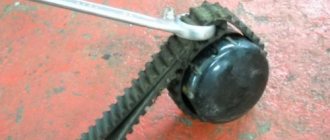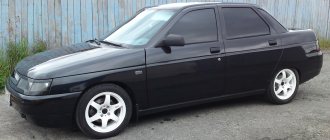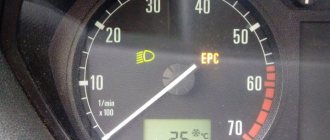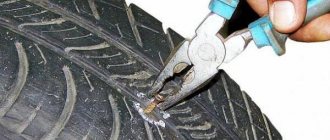The longer engine oil is used, the more impurities it contains: dust, dirt and fuel combustion products. All this pollutes it, makes it thicker - as a result, the oil cannot fulfill its purpose and does not reduce friction between the moving parts of the engine. The internal combustion engine that receives such a mixture wears out faster and breaks down earlier.
Therefore, to protect the internal combustion engine, a special cleaning device is used - an oil filter. Its design and principle of operation are simple: it is a cylinder-shaped filter element and a housing, which is a container for oil. Through the bottom with holes, the liquid penetrates into the device and passes through the filter paper. The purified oil then goes to the engine.
Oil filters differ for different car models. They come in two types:
- Non-separable. The metal housing of this filter is one-piece - it is removed along with the filter element inside. These devices are more expensive because they are easier to replace: you just need to unscrew the used part and install a new one in its place.
- Collapsible . In such a part there is access to the filter element - it is this that needs to be changed, while the housing remains in the filter seat. These devices are cheaper - in fact, only the cartridge with the filter curtain is sold. But installing it is not so convenient: each time you need to disassemble the structure, wash the housing and other reusable parts from oil and dirt, and then put everything back together before installing the filter.
Non-removable filters are more difficult to recycle and less environmentally friendly, but this type is the most common. Most of these parts are similar and interchangeable. Almost all of them are cleaned mechanically - with the help of special paper or cardboard, contaminants are filtered out, but oil passes through the pores.
However, over time, the curtain becomes clogged and may no longer allow liquid to pass through. Then the oil will enter the engine in another way - through a bypass valve, which, under pressure, passes the unclean mixture into the internal combustion engine. This is an extreme measure to which it is better not to take the cleaning system. To ensure that clean oil gets into the engine, and not a tarry mixture mixed with dust and soot, the oil filter needs to be replaced in a timely manner.
show more
Reasons why the oil filter is not dismantled
To unscrew the old filter, you need to place the car on a pit or lift the car using a lifting device. Then you need to unscrew the old filter, but difficulties may arise here. If it does not come off, this may be due to its sticking. The motor becomes very hot during operation. Because of this, parts that are not very heat-resistant melt. Such components include a rubber gasket, which is included in the design of the oil filter. It can melt and stick to the engine, especially if oil gets on the gasket.
Problems arise when the filter is twisted too tightly. When changing the filter element, you need to tighten it well so that the rubber band is pressed tightly against the motor. In this case, the oil filter is often screwed on too tightly, especially when using a wrench. If you take into account the melting of the gasket, it becomes clear that unscrewing the filter will be enough.
It is important that the oil filter is not located in the most convenient place, therefore, it becomes impossible to exert maximum effort to unscrew it. In addition, when unscrewing, your hands get dirty with oil and slip.
Why can't I keep the old filter?
The oil in a car engine is changed every 10-15 thousand kilometers or once a year. When using a vehicle in difficult conditions, the replacement interval for consumables will be shorter. Oil service life depends on the specific brand of fluid and the vehicle. It is necessary to change the oil filter when changing consumables.
The motor is the main unit of the machine, which is subject to rapid wear during operation because it operates under high loads. Over time, foreign substances begin to appear in the lubricant, which negatively affect the functionality of the internal combustion engine. To prevent their impact on the power unit, an oil filter is used. The higher the wear of the device, the lower the quality of the oil, and this will sooner or later affect the operation of the internal combustion engine.
Moreover, it will not be possible to determine the suitability of the filter element visually, nor will it be possible to draw conclusions about the need for replacement based on mileage alone. The lubricant cleaning device always works, including when the engine is idling. Its wear is determined not by the mileage of the car, but by the number of engine hours worked. And it doesn’t matter whether it’s a VAZ 2109, 2110 or a foreign car.
Why change the oil filter?
The recommended mileage after which an oil change is necessary is on average 15 thousand km. It all depends on operating conditions, the degree of engine wear, and driving style. For example, when constantly moving with a trailer, it is recommended to change the lubricant more often. The same can be said about drivers who prefer an aggressive driving style. Each oil change is accompanied by the installation of a new filter.
Inexperienced drivers sometimes do not understand why this element needs to be changed: they say, it is enough to fill in fresh oil. The fact is that any lubricant that is poured contains foreign particles that negatively affect the operation of the engine. Plus, there are always tiny chips inside the motor, and dirt can get inside it. All this needs to be sifted out, which is what the oil filter does. It has been calculated that if it were not there at all, the engine’s service life would be reduced by five (!) times.
Why might this be needed?
Car manufacturers recommend changing the engine oil every 15 thousand kilometers. Under difficult operating conditions, for example, when traveling with a trailer, the lubricant is changed more often. When changing the oil, it is advisable to change the oil filter.
Many car enthusiasts do not understand the reasons for replacing the oil filter when the lubricant is changed. The engine is the heart of the car; it is subject to the greatest wear and tear, since it bears the main load. The engine fluid being poured contains foreign particles that have a bad effect on the operation of the engine. An oil filter is designed to filter out these particles. The more it is worn, the worse the quality of the lubricant becomes, and this, in turn, affects engine wear.
Structure of the filter element
It is impossible to determine the suitability of an oil filter by appearance. It is also difficult to draw conclusions about the need for replacement based on mileage. The filter element works constantly, even when the engine is idling, so its wear depends not on mileage, but on engine hours. Some drivers, when changing the oil, neglect to replace the filter element, considering it unnecessary.
When choosing a replacement product, it is important to focus not on its appearance, but on its content. Drivers with an aggressive driving style are better off installing expensive products. This is due to the fact that when driving fast, hard braking or accelerating, the engine requires a large amount of oil. Expensive filters have synthetic elements that can withstand loads and high temperatures well, allowing the oil to pass through quickly. Analogues have felt-based elements through which the lubricant passes longer than through synthetic material. These products are suitable for lovers of a quiet ride.
Which way should you unscrew?
To dispel doubts, you need to know that the thread of the filter is “correct” - it is screwed clockwise and unscrewed counterclockwise. And the fact that it does not give in means that the force applied is not enough. Either there is not enough strength, or the “lever” is short - the hands are in an awkward position due to the tightness of the engine compartment.
In this case, you need to use a special oil filter wrench. And if the puller is not in the garage, then choose a suitable means at hand that will essentially do the same thing - create a more powerful torque by increasing the length of the lever or the force of impact.
How to make a timing belt puller
Every garage probably has a couple, or even more, old timing belts. So they can be used to make a puller for the oil filter.
The simplest option is to use a timing belt with a lever made from a spanner or open-end wrench.
However, it is better to make a simple puller so as not to spoil the tool, which is not intended for such work. It does not take a lot of time.
The basic tools we need are a grinder and an electric drill (or a good screwdriver).
First of all, in the extended M12 nut, using a drill with a diameter of 12 mm, you need to drill out the internal thread to a depth equal to the width of the timing belt.
Next, we clamp the elongated nut in a bench vice, screw it onto a pin, arm ourselves with a grinder with a cutting disc and cut out a groove. We process its inner edges with a 3 mm thick sanding disc.
After this, all that remains is to insert the timing belt into the seat.
The principle of operation is very simple: we put the belt on the oil filter, after which, using a spanner wrench as a lever, we try to unscrew it.
The step-by-step process of making a homemade product can be seen in the video below.
Universal oil filter wrench. Do it yourself (without machines or welding).
Second method
Unscrew the oil filter using special keys previously purchased at a car store; they come in two main types:
- Chain key.
- Crab Key.
Chain key
crab key
Having decided to purchase a special key, choose the first option; it is more reliable and is more often used by service station workers.
Removal using special pullers
Service technicians and experienced garage repairmen use special pullers to remove the filter element. They are available in 3 types:
- chain;
- crab;
- clamping (tape, screw).
Experts prefer chain pullers, which have greater power and reliability and are suitable for any type of filter elements. Therefore, service station technicians usually remove the oil filter with a chain wrench.
Special pullers can be purchased at auto stores. The key is placed on the body of the part being removed and securely fixed. It remains to remember that the dismantled element must be unscrewed counterclockwise. After removing the filter, make sure that the gasket is not stuck to the motor block. If necessary, remove the gasket or its parts with a scraper.
Method No. 2.
When it was not possible to unscrew the oil filter using the first method, then instead of a towel we take sandpaper. From a piece of sandpaper, cut a strip with a width equal to the height of the oil filter. Then we wrap a cut piece of sandpaper around the oil filter and unscrew it.
This method allows you to unscrew not only a tightly tightened oil filter, but also a stuck one. However, not every stuck filter can be unscrewed with sandpaper, so method No. 3 comes to the rescue.
Popular manufacturers
It's no secret that a brand is often an indicator of quality. Therefore, when choosing a filter, try to focus on the manufacturer. Now there are a lot of them, but among this diversity several leaders can be identified. They have proven themselves well as manufacturers of oil filters for the VAZ 2110.
If you are interested in inexpensive solutions, then pay attention to such companies as:
- Alpha;
- Vicks;
- SKT;
- Zolex;
- UFI.
Alpha is a domestic filter made in Russia. Zolex, SKT and UFI products say that these are German and Italian filters. But in fact, they were produced in China by order of German and Italian companies. Consequently, Germany and Italy are indicated on the packaging, but the quality is still Chinese, since the filters are made in the Middle Kingdom.
Alpha
As the practice of VAZ 2110 owners shows, the most optimal in terms of functionality, reliability and quality was, oddly enough, the domestic Alpha filter.
There are also medium-priced oil filters that are in demand among “ten” owners - Belgian-made Champion and Standard from our Russian manufacturer.
Their quality is decent, no complaints. In terms of price-quality ratio, the choice should be made in their favor.
Which way to unscrew the oil filter?
When difficulties arise with unscrewing the filter element, the motorist may begin to be tormented by doubts regarding which direction the device should be unscrewed. Remember that the oil filter must be unscrewed counterclockwise (to the left). In the same way, a regular nut or bolt is unscrewed (if you do not take into account fasteners with reverse threads).
If you cannot unscrew the oil filter on your own, ask a stronger person for help. In fifty percent of cases this method works. The main thing is to achieve a breakdown from the starting point. This is easier to do with a warm engine. When the engine cools down, it becomes difficult to unscrew the filter.
For dismantling, you can use one of the following methods:
One of the factory oil filter wrenches
1. Special key. In stores selling car accessories, you can find a wrench that is designed to unscrew the oil filter. It can be one of three types:
- chain;
- crab;
- clamping
Such a tool needs to be hooked onto the filter. After that, start rotating it.
You will also be interested in:
- How to reduce engine oil consumption
- Checking the engine oil using the marks on the dipstick
- Why does the engine produce blue or black smoke?
How to unscrew the oil filter with a special wrench
There are many types of pullers. Here is a description of some of them:
- Tape. Handle with a grip in the form of an open ring made of steel tape. One end is attached through a hinge to the handle itself, the second - through a hinge to the movable rocker arm. When you turn the handle counterclockwise, the rocker starts to move, the ring moves together, decreasing in diameter, the tape wraps around the filter body and sets it in motion.
- Belt. The principle of operation is very similar to belt ones, but only one end of the belt is attached to a hinge to the rocker arm. The second one is free. The free end is wrapped around the body, passed into the rocker arm, and the belt is “pinched” by turning the handle counterclockwise. Continuing the movement of the handle, unscrew the stubborn element.
- Chain. A loop from a chain, similar to that from a timing belt or bicycle, is clamped in a head with a hole for the square of the handle from the set with socket heads. They wrap the filter in a loop, insert a square into the head, and wind the chain around the head until it clamps the housing and turns it.
- Ticks. Keys modeled after pliers. They consist of two handles with semicircular toothed girths on a hinge joint. They work like a locksmith's analogue.
- Crescent-shaped. With one handle, one movable serrated girth and a fixed short serrated end. A simplified version of the previous key.
- End, cup-shaped. Puller heads. For professionals, they are sold in the form of kits for different sizes of oil filters. You can buy only one for a specific car make and type of filter element.
- Crabs. They belong to universal end pullers with three movable self-clamping “legs” at an angle of 120° relative to each other. They are activated, like the cup-shaped ones, by a square inserted into the hole at the end of the key.
Crab puller
A more interesting and absolutely universal thing is the crab puller. Simple and ingenious design. The device consists of two plates, between which there are grippers with notches. These notches prevent the device from rotating, and on the plate side, each of the grips has a toothed clamping mechanism crown.
The clamping mechanism can work in both directions, which allows you to both install and dismantle the filter. In this case, the device grips the body firmly enough without deforming it. To increase the applied force and to activate the clamping mechanism, a tetrahedron is inserted into the puller, and you can also work with a regular open-end or spanner wrench. It all depends on the amount of free space around the filter. The device is excellent, but it is also unlikely to be possible to make it yourself, and there is no point in doing so. Its price is within 600 rubles.
What to do next?
When the old filter is removed, before installing a new one in its place, be sure to wipe the mounting area with a rag, pour oil into the filter itself, and do not forget to lubricate the rubber gasket with it. Only after this can the new part be considered ready for installation. Screw it into place (you don’t need to put much effort into this), turn on the ignition and let the engine warm up, while you observe the repair site. If everything is done correctly, oil will not ooze out from under the filter.
Method number 3.
Method No. 3. Sticky oil filters can only be unscrewed using this method. The oil filter housing is made of aluminum, which is very easily pierced by a sharp object.
To unscrew the filter, you need to take a screwdriver with a long blade and use a hammer to pierce the oil filter with the screwdriver so that the blade of the screwdriver comes out on the back side. Using a screwdriver inserted into the pierced housing, unscrew the oil filter.
There is only one drawback: a lot of oil leaks from a broken filter, which very dirty the engine compartment.
If you change the engine oil yourself and unscrew the oil filter, then give it a like (thumbs up) and also subscribe to the
“NovAuto” .
Method 1: Using a strong, sharp screwdriver and hammer
This is the simplest of all possible options.
The principle is as follows:
- Take a large flat screwdriver and use it to punch a through hole in the filter housing (the metal is thin, so this can be done with almost one blow).
- Next, you need to grab the handle of the screwdriver and apply force in a counterclockwise direction. Due to the increase in the force arm, the filter breaks off quite easily, after which it can be unscrewed by hand.
Please note that the oil can remain hot for a long time, so safety precautions must be observed.
Inconveniences for the driver
Car modifications have individual principles for attaching the oil filter. What remains common is the lack of space around them, since the layout of the power units is so compact that it is almost impossible to “crawl” in to screw together the oil cup. Difficulties include the adhesion of rubber seals to metal.
Based on the above, they conclude that a specific engine requires “its own” device or universal puller. When developing your own design, you need to focus on factory analogues of oil filter pullers sold in car dealerships.











